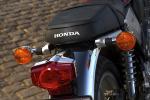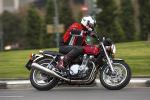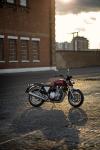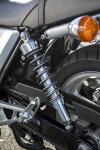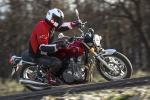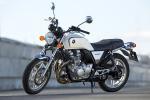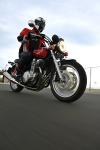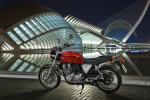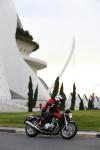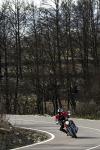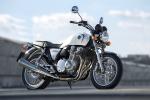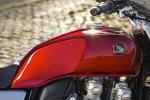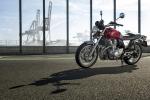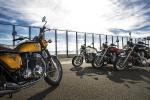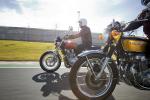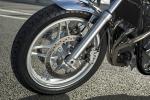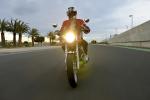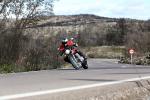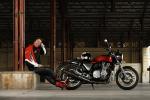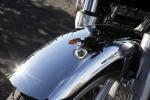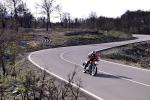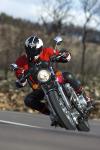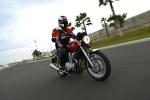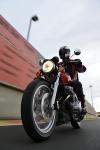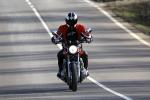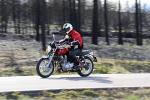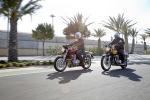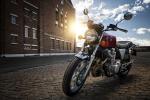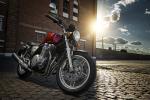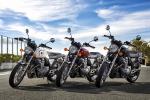Honda CB1100 2013 review
By Kevin Ash - 18/01/2013
Honda has raised the bar with the new CB1100: it's not just the style which is retro, the handling and engine have been given an old school flavour too.
That's not to say the bike weaves and bobs through high speed corners or runs on two cylinders in the wet, but there has been a deliberate attempt to reproduce more than the obvious styling cues with the latest CB. Honda put experienced engineer Hirofumi Fukunaga in charge of the project, a sign of how important it was to them, and sure enough he's worked retro features deep into the bike's engineering, as well as its look.
See the Hirofumi Fukunaga interview here for more detail - it's an interesting one!
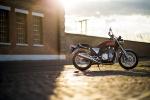
The CB1100 is designed to celebrate air-cooled Honda fours generally, rather than any one model in particular, and there are plenty of recognisable visual cues. The exhaust nods at the 1970s 400-Four, the tail-light and green dials are generic seventies Honda, the wheels are Comstar inspired, the mudguards are chromed and the engine has the look of the first air-cooled, DOHC models such as the CB900F, largely due to the widely spaced camshafts with their chrome end caps.
But there's a lot more to it. The cooling fins for example are a thin 2mm in section at their tips, as they used to be three decdes ago, in part to enhance that seventies style but also because these tick and ping characteristically when the engine's cooling after a hard run - and sure enough, they do. On cylinders one and two, the inlet valves close slightly earlier than on cylinders three and four, a move designed to give the engine a slighly rough, lumpier feel in imitation of older designs.
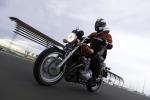
The chassis revives narrow tyres and bigger wheels, using a 110mm front and 140mm rear on 18 inch rims, and the Metzelers fitted have a single radius profile, as older tyres used to. The geometry is old fashioned too, with a 27 degree rake angle, long 1490mm 58.7in) wheelbase and 114mm (4.49in) trail. You also get twin shocks and a tubular steel double cradle frame, although a closer look reveals the tubes are much thicker than they would have been 30-odd years ago.
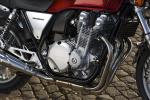
The engine hides plenty of modern technology despite its retro appearance. As well as the staggered intake timing, there are air vents through the head and carefully routed oilways inside it, all designed to keep the spark plugs cool. Heat dispersion within the cylinders is helped by the use of all-aluminium barrels with sintered aluminium sleeves, and unlike older Honda fours, there are four valves per cylinder. The outer two exhaust pipes exit at an angle so they can clear the two frame downtubes.
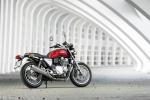
The relatively low power output of 84bhp (85PS, 66kW) means the engine is not highly stressed, so even though this is Honda's first new air-cooled four for 20 years, it passes all current and predicted emissions regulations. No more carburettors though, so the CB gets four 36mm throttle bodies with fuel injection. The bore and stroke dimensions are less oversquare than current practice generally, at 73.5mm x 67.2mm, a ratio of 0.914 compared with 0.753 for the Fireblade.
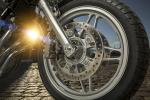
Theer are plenty of neat touches, like the fuel tank deliberately being made narrow enough so you see the engine below when sitting on the bike, and the brakes are Honda's first 'hubless' disc design, meaning the front discs are attached directly to the wheel rather than on a central carrier. This gives the front end a cleaner look. Like the rear light, the indicators have a period look, and you also get helmet locks on each side of the seat, just like old bikes used to have - there's even a centre stand, remember those?
The bike has been available in Japan for three years now but there are significant differences in the European version's spec, including a wider air cleaner aperture, no flap in the silencer and revised fuel injection settings, which together have given the engine a substantial gain in torque below 3,000rpm.
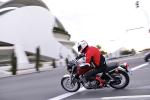
This wouldn't matter on a lot of bikes, but the CB1100 has the most tractable engine I've ever used. Even in fifth gear (top) I found I was using lower and lower revs, simply because the engine was comfortable with it, until as an experiment I let the revs drop to 500rpm, and still the bike pulled away without a hint of transmission protest and strongly enough for everyday riding. That's half the idle speed! As an experiment I left the bike in top gear across one of the small towns we rode through, which included some red traffic lights and roundabouts where I had to stop, and aside from a little more clutch slip than usual it coped just fine.
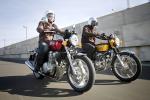
This is very much a low and mid-range engine, as you'd expect, and it's strong and responsive here without threatening to rip your arms off. But the bike overtakes cars with little need to drop a gear and gets fast enough to be exciting and stretch the chassis. Some patches of tingling vibration come and go as the revs rise, but there's nothing intrusive, although at some steady motorway speeds you could end up with the odd numbed digit. This isn't an issue generally though, and the engine does have a pleasing, gravelly sound that's a more welcome characteristic from the past. Spin it into the red line above 9,000rpm and it feels flat, but that's not what the bike is about, and it has enough muscle for anything but harder sports riding, along with, ironically, more character than the original four-cylinder engines whcih inspired it.
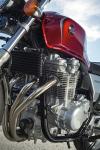
Honda claims a fuel consumption figure of 51.5mpg (18.2km/l, 5.49l/100km, 42.8mpg US) in general riding, which wasn't possible to check on the presentation, but generally I get around 10-12 per cent less than Honda's claims so 45mpg is a realistic expectation, and it could be better. That would mean a range of 145 miles (230km), which will be adequate for many buyers but some will find it restrictive, especially when venturing on the longer trips which the bike is perfectly capable of. It's going to put a few people off, that's for sure.
Comfort is good after all, a day in the seat caused me no problems and the slight forward lean and spacious riding position are fine for most kinds of riding. The seat is low - the official figure is 31.3in (795mm) but the slim tank and front part of the seat help in reaching the ground too.
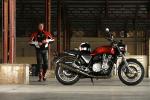
In keeping with the attention to detail, the general finish is outstanding, especially the deep, liquid gloss of the tank paint. This comes in white, red or black and looks stunning in red in the sunshine, while many other components are deep chrome, polished aluminium or a high quality plastic. The impression is that Honda really cares about this bike, as if because it's flying the flag for the company's heritage they've needed to put in some extra effort.
What some riders might not get on with though is the handling, simply because it's so different to what they're used to. All those retro chassis parts have had an effect and the feel is quite different as a result. The steering is extremely light, which is fine for agility around town but there's little feel in the straight ahead position, while the bike rolls into a turn with disconcerting speed, then changes direction slowly. It's all a bit odd unless you've had experience of seventis bikes, in which case there's something familiar about it. What you don't get though is the awkward feeling of lots of mass concentrated around the headstock that many bikes used to have, the CB1100 instead having excellent balance at low speeds which also helps it around town. It steers well too, just occasionally hinting at a tendency to drop into turns at lower speeds which never really seems to materialise.
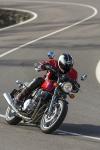
The suspension meanwhile works very well, getting just a little choppy on bumpy roads at higher speeds but providing a really good and sometimes plush ride quality the rest of the time. There's nothing retro about the brakes though, which have plenty of power with decent feedback and ABS as standard.
Honda says its research has showed many customers will be those interested in classic bikes but who don't want the hassle and reliability issues of riding a 30 or 40 year-old machine. There's little doubt the CB1100 will be utterly dependable, and it will also meet the desire for some authenticity, even as a pastiche of a range of older machines, as the lineage is clear and the execution excellent. What surprises many people though is how many youngsters are going for this kind of machine - it's the same with Bonnevilles and the W800, as these are what many new riders think of as looking like proper motorbikes. The Honda does the same.
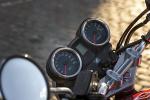
Another surprise is how few accessories Honda has produced. The bike is lining up to do the same job as the Bonneville and W800 for Triumph and Kawasaki, the Monster for Ducati or even the Sportster for Harley, yet you can only buy a handful of bits and bobs for it, where these other machines, especially the European and American ones, have whole catalogues of extras. Honda though is still uncertain about sales, which is why the bike has not even come to Europe until now, and the company's rich heritage hasn't had the same appeal here as the home grown brands'. But if any bike can change that, it's the CB1100. It's a handsome machine in its own right, it has all the right styling cues but it also offers some real character along with hints of the feel and sound of an older machine.
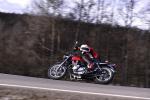
The fact that some reviewers actively didn't like it, as opposed to be being unmoved either way, to me confirms Fukunaga has done an especially good job here. The big fear was that the CB1100 would be bland and boring, but instead it's evoked emotions and opinions in people. I happen to like it a lot and particularly appreciate the care and attention to detail that's gone into the engineering as well as the styling.
Honda CB1100 comments forum thread here
Specifications
Model tested: Honda CB1100
UK price: £8,950
Available: March 2013
Engine: in line, four cylinder, air cooled, dohc 12v, 1140cc
Power: 84bhp (85PS, 66kW) @ 7,500rpm
Torque: 69b.ft (9.46kgm) @ 5,000rpm
Economy: 51mpg (18.2km/l, 5.49l/100km, 42.8mpg US) (claimed)
Tank/Range: 3.2 gallons (14.6 litres, 3.9 gallons US) / 145miles (230km)
Transmission: Five gears, wet, multi-plate clutch, chain final drive
Frame: tubular steel cradle
Seat height: 31.3in (795mm)
Wheelbase: 58.7in (1490mm)
Rake/trail: 27 °/ 4.50in (114mm)
Weight: 547lb (248kg) wet
Donate to the Kevin Ash Fund
Kevin's funeral was held on Thursday 28th February 2013 and was well attended by family, friends and colleagues.
The Telegraph has very kindly established The Telegraph Kevin Ash Fund to assist with the education of Kevin's three daughters.
If you'd like to make a donation then you can use the PayPal 'Donate' button below which will allow you to donate from your PayPal account, or via credit or debit card. A small percentage (about 3.4%) will be retained by PayPal for the service.
Kevin's family have been touched by the generosity and messages of support from people using the website and would like to express their gratitude to those who have contributed in any way.
The donations keep coming in, thank you so much, and the family especially like it when you leave a message.
Home | ![]() facebook.com/KevinAshFund
|
facebook.com/KevinAshFund
| ![]() twitter.com/KevinAshFund | © 2013
twitter.com/KevinAshFund | © 2013
